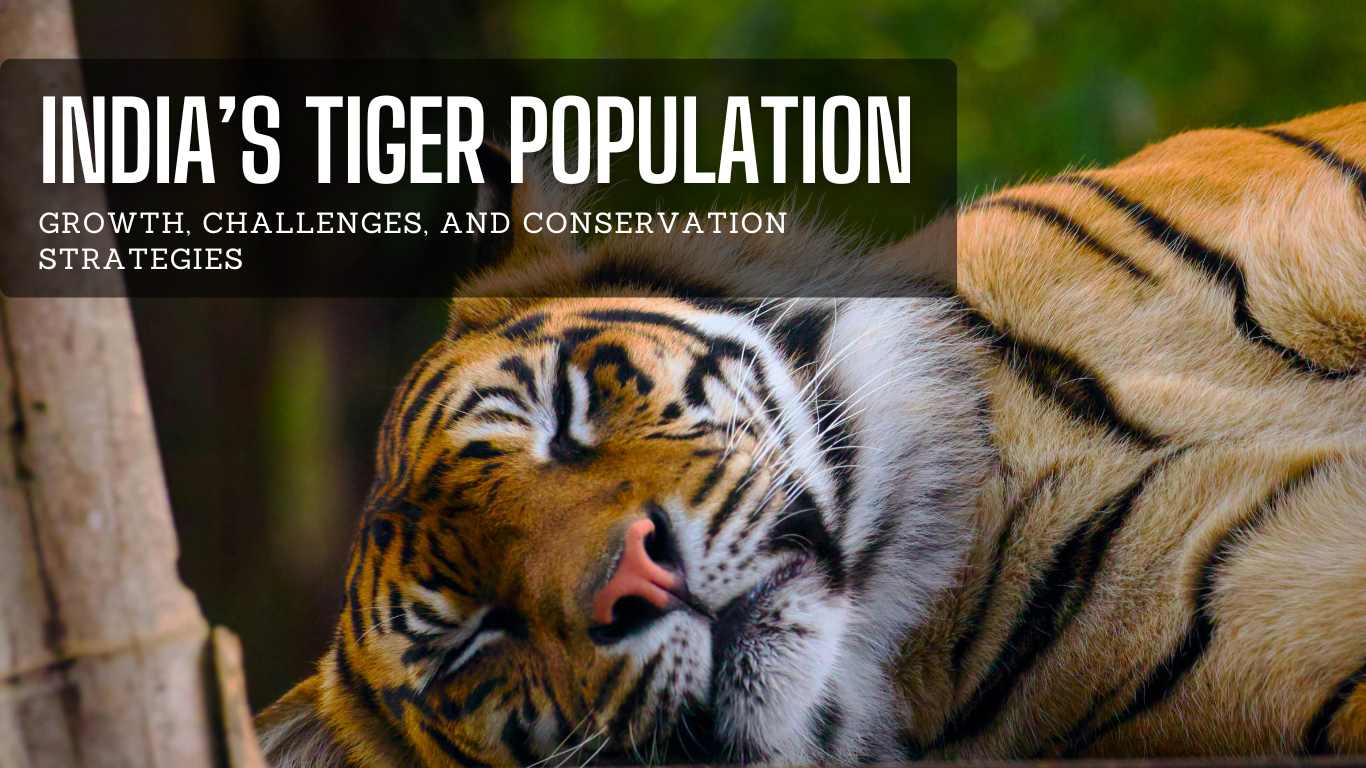India, home to nearly 75% of the world’s tigers, has witnessed a steady increase in its tiger population, reflecting the success of conservation initiatives. According to the All India Tiger Estimation 2022, the current population stands at 3,682 (range: 3,167-3,925), a significant rise from 2,967 in 2018 and 2,226 in 2014. With a 6% annual growth rate in consistently sampled areas, this increase underscores India's commitment to tiger conservation. However, this progress also presents challenges such as habitat loss, human-wildlife conflict, and socio-political influences that continue to shape tiger survival.
Conservation Strategies and Government Initiatives
The National Tiger Conservation Authority (NTCA), under the Government of India, has adopted a three-pronged strategy to manage human-wildlife conflict and support tiger conservation:
1. Material and Logistical Support: Through the Centrally Sponsored Scheme of Project Tiger, funding is provided to reserves for infrastructure development, conflict management, and staff training. Financial aid is extended for ex-gratia compensation, awareness campaigns, and procurement of equipment, including immobilization tools and tranquilizers.
2. Restricting Habitat Interventions: Conservation efforts focus on balancing tiger populations within reserves. If a reserve reaches its carrying capacity, interventions are limited to prevent excessive wildlife spillover, thereby reducing human-animal conflicts. In buffer zones, habitat modifications are controlled to ensure tigers naturally disperse to other rich forested areas.
3. Standard Operating Procedures (SOPs): The NTCA has issued three SOPs to manage conflict situations:
o Straying of Tigers in Human-Dominated Areas
o Tiger Attacks on Livestock
o Relocation of Tigers from Source Areas to Less Populated Landscapes
These SOPs help in managing dispersing tigers, preventing livestock-related conflicts, and ensuring population balance across landscapes. Additionally, under Tiger Conservation Plans (TCPs), site-specific interventions are undertaken, supported by Project Tiger funding.
Tiger Occupancy and Habitat Expansion
A recent study published in Science highlights a 30% increase in tiger occupancy across 138,200 sq. km over the past two decades. While protected areas (PAs) covering 35,255 sq. km serve as prime tiger habitats, tigers have also moved into areas inhabited by nearly 60 million people.
The study analyzed tiger recovery across 20 Indian states from 2006 to 2018, dividing landscapes into fixed 10x10 km grids. Findings reveal a gradual expansion of tiger habitats:
- 2006-2010: 35% of new areas colonized
- 2010-2014: 20% of new areas colonized
- 2014-2018: 45% of new areas colonized
Tigers prefer habitats with high prey density, low human activity, and moderate economic prosperity. Their occupancy is closely linked to the distribution of prey species such as spotted deer (Axis axis), sambar deer (Rusa unicolor), swamp deer (Rucervus duvaucelii), and gaur (Bos gaurus). These herbivores significantly influence tiger presence.
Moreover, tiger habitats overlap with other large carnivores and megafauna:
- Asian elephants (59%)
- Gaur (84%)
- Leopards (62%)
- Dholes (68%)
- Sloth bears (51%)
This reinforces the umbrella species concept, where tiger conservation indirectly benefits entire ecosystems by preserving biodiversity and contributing to carbon sequestration—an essential factor in combating climate change.
Local Tiger Extinctions and Conservation Challenges
Despite positive growth, local extinctions have been recorded in 17,992 sq. km over 12 years, with the highest losses occurring between:
- 2006-2010: 64% of total local extinctions
- 2010-2014: 17%
- 2014-2018: 19%
The worst-affected areas are in eastern India, particularly Chhattisgarh, Odisha, and Jharkhand, where reserves such as:
- Guru Ghasidas
- Palamau
- Udanti-Sitanadi
- Similipal
- Satkosia
- Indravati
face severe conservation threats. These regions, among India’s poorest districts, suffer from bushmeat hunting, poaching, and habitat degradation, making it difficult for tigers to thrive.
Impact of Armed Conflict on Tiger Conservation
One of the study’s most striking revelations is the direct link between armed conflict and tiger extinction. Nearly 47% of tiger extinctions were recorded in areas affected by Naxalite insurgencies, particularly in Chhattisgarh (Indravati, Achanakmar, Udanti-Sitanadi) and Jharkhand (Palamau).
However, regions where armed conflict has subsided, such as Nagarjunsagar-Srisailam, Amrabad, and Similipal, are witnessing tiger recovery. Yet, armed insurgencies in Odisha, Chhattisgarh, Jharkhand, Telangana, Andhra Pradesh, and Maharashtra continue to hinder conservation efforts, creating unstable environments for wildlife protection.
Human-Tiger Coexistence: Socioeconomic Impacts
Interestingly, tigers thrive in some densely populated states like Madhya Pradesh, Maharashtra, Uttarakhand, and Karnataka, where conservation efforts are supported by:
- Eco-tourism revenue
- Government compensation schemes
- Community-based conservation projects
These areas have successfully managed human-wildlife coexistence, with locals benefiting from tiger-related tourism and conservation initiatives.
Conversely, tiger colonization rates are lowest in high-poverty rural areas, where communities rely heavily on forests for livelihood. The lack of alternative income sources and proper awareness makes conservation efforts difficult in these regions.
Sustainability and Future Conservation Strategies
The study emphasizes that economic prosperity plays a dual role—while sustainable eco-tourism and conservation funding enhance tiger recovery, excessive urbanization and land-use change can negatively impact tiger habitats.
Investments in eco-development projects and community participation are crucial to ensuring sustainable conservation. Protected areas can serve as models for biodiversity conservation, poverty alleviation, and ecosystem services, ensuring local communities benefit from conservation success.
At the same time, strict enforcement of wildlife laws is necessary to combat poaching, habitat destruction, and encroachments. Legislative measures such as:
- Land protection policies
- Prohibition of forest land diversion
- Sustainable development planning
must be upheld to safeguard tiger populations.
Conclusion
India’s tiger conservation efforts showcase a global success story, with legal frameworks, scientific monitoring, and government interventions playing a pivotal role. However, the challenges of habitat fragmentation, human-wildlife conflict, armed insurgencies, and socioeconomic disparities require continued attention.
Future strategies must focus on:
- Balancing conservation with economic development
- Enhancing community participation
- Strengthening anti-poaching efforts
- Ensuring sustainable land-use practices
By maintaining a holistic and inclusive approach, India can continue to lead the world in tiger conservation, securing a future where tigers and humans coexist harmoniously.
|
Main Question: Discuss the role of socio-economic factors such as poverty, armed conflict, and land-use changes in influencing tiger occupancy and local extinctions in India. Provide examples to support your arguments. |







